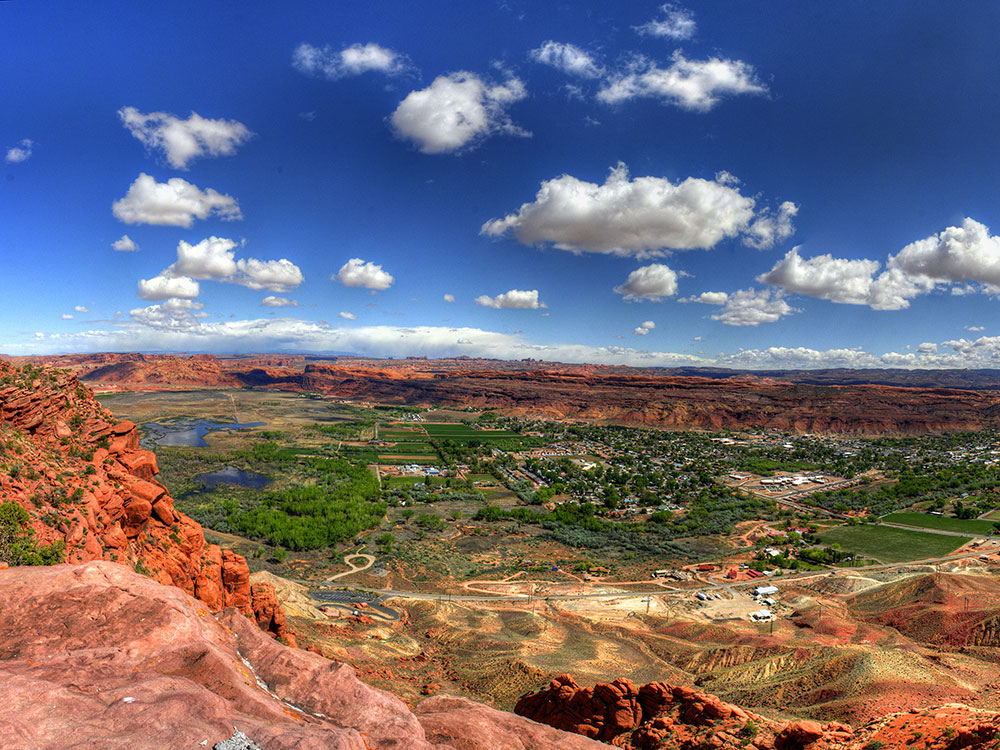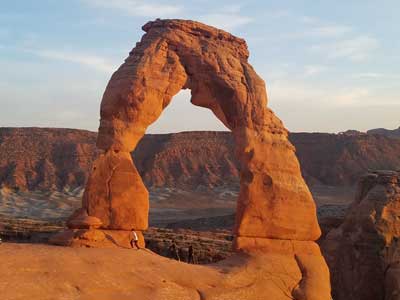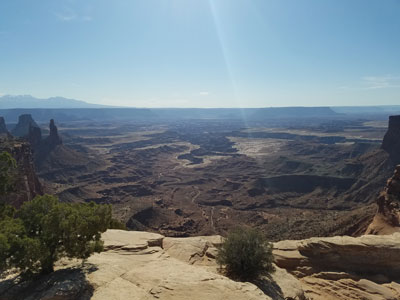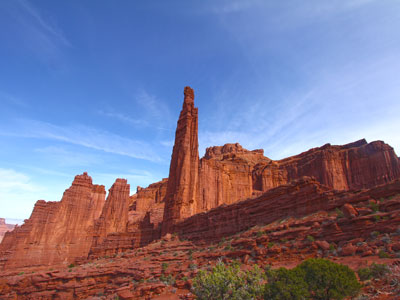Known for its dramatic scenery, Moab attracts many tourists annually, mostly visitors to the nearby Arches and Canyonlands national parks. The town is a popular base for hikers and mountain bikers who ride the extensive network of trails
From Page, AZ (273 miles): Follow AZ-98 E to US-160 E in Navajo County. Follow US-160 E and US-191 N to E Center St in Moab. Turn right onto E Center St.
Overview
Moab is the largest city of, and the county seat on the southern edge of, Grand County in eastern Utah, known for its dramatic scenery. Moab attracts many tourists annually, mostly visitors to the nearby Arches and Canyonlands National Parks. The town is a popular base for mountain bikers who ride the extensive network of trails including the Slickrock Trail, and for off-roaders who come for the annual Moab Jeep Safari.
The Biblical name Moab refers to an area of land located on the eastern side of the Jordan River. Some historians believe the city in Utah came to use this name because of William Andrew Peirce, the first postmaster, believing that the biblical Moab and this part of Utah were both "the far country". However, others believe the name has Paiute origins, referring to the word moapa, meaning "mosquito". Some of the area's early residents attempted to change the city's name, because in the Christian Bible, Moabites are demeaned as incestuous and idolatrous. One petition in 1890 had 59 signatures and requested a name change to "Vina". Another effort attempted to change the name to "Uvadalia". Both attempts failed.
During the period between 1829 and the early 1850s, the area around what is now Moab served as the Colorado River crossing along the Old Spanish Trail. Latter-day Saint settlers attempted to establish a trading fort at the river crossing called the Elk Mountain Mission in April 1855 to trade with travellers attempting to cross the river. Forty men were called on this mission. There were repeated Indian attacks, including one on September 23, 1855, in which James Hunt, companion to Peter Stubbs, was shot and killed by a Native American. After this last attack, the fort was abandoned. A new group of settlers from Rich County, led by Randolph Hockaday Stewart, established a permanent settlement in 1878 under the direction of Brigham Young. Moab was incorporated as a town on December 20, 1902.
Moab's economy was originally based on agriculture, but gradually shifted to mining. Uranium and vanadium were discovered in the area in the 1910s and 1920s. Potash and manganese came next, and then oil and gas were discovered. In the 1950s Moab became the so-called "Uranium Capital of the World" after geologist Charles Steen found a rich deposit of uranium ore south of the city. This discovery coincided with the advent of the era of nuclear weapons and nuclear power in the United States, and Moab's boom years began.
The city population grew nearly 500% over the next few years, bringing the population to near 6,000 people. The explosion in population caused much construction of houses and schools. Charles Steen donated a great deal of money and land to create new houses and churches in Moab.
With the winding down of the Cold War, Moab's uranium boom was over, and the city's population drastically declined. By the early 1980s a number of homes stood empty, and nearly all of the uranium mines had closed.
In 1949, Western movie director John Ford was persuaded to use the area for the movie Wagon Master. Ford had been using the area in Monument Valley around Mexican Hat, Utah, south of Moab, since he filmed Stagecoach there 10 years earlier in 1939. A local Moab rancher (George White) found Ford and persuaded him to come take a look at Moab. There have been numerous movies filmed in the area since then, using Arches National Park and Canyonlands National Park as backdrops.
Since the 1970s, tourism has played an increasing role in the local economy. Partly due to the John Ford movies, partly due to magazine articles, the area has become a favorite of photographers, rafters, hikers, rock climbers, and most recently mountain bikers. Moab is also an increasingly popular destination for four-wheelers as well as for BASE jumpers and those rigging highlining, who are allowed to practice their sport in the area. About 16 miles (26 km) south of Moab is Hole N" The Rock, a 5,000-square-foot (460 m2) 14-room home carved into a rock wall which National Geographic has ranked as one of the top 10 roadside attractions in the United States. Moab's population swells temporarily in the spring and summer months with the arrival of numerous people employed seasonally in the outdoor recreation and tourism industries.
Moab is known for its opportunities for outdoor recreation in stunning natural settings; activities include the following:
- 4x4: Multi-day camping trips in Canyonlands National Park on the White Rim Road, and Extreme 4x4 at Sand Flats Recreation Area among other areas
- Whitewater rafting and kayaking on the Colorado River. The area's most famous sections of the Colorado are Westwater Canyon which is upstream from Moab and Cataract Canyon in Canyonlands National Park which is downstream.
- Canoe trips on the Green River
- Mountain biking: Hundreds of miles of trails easily accessible
- Road biking: The annual Skinny Tire Festival is held in Moab, including a century ride
- Rock climbing: A true international destination for climbers
- BASE jumping: Legal in many areas near Moab
- Hiking and backpacking: Canyonlands National Park, Arches National Park, and thousands of square miles of BLM and national forest lands surround Moab.
- Slacklining/highlining: World record for long highlines was performed here Off-road trails
Moab is famous for canyoneering, hiking, river rafting, biking, motorcycling, ATV riding, and 4x4 driving. The Moab area is home to many easy to difficult off-road trails for novice to experienced off-roaders.
This article uses material from the Wikipedia article "Moab, Utah", which is released under the Creative Commons Attribution-Share-Alike License 3.0
Featured Locations
Arches National Park
National park known for more than 2,000 natural sandstone arches, including the well-known Delicate Arch
Canyonlands National Park
Park preserves a colorful landscape eroded into numerous canyons, mesas, and buttes by the Colorado River, the Green River, and their respective tributaries
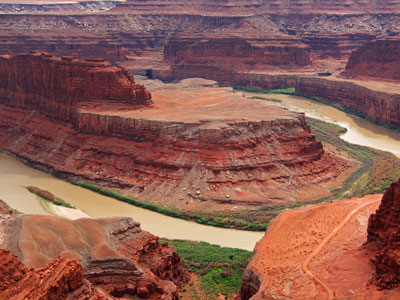
Clément Bardot, CC BY-SA 3.0, via Wikimedia Commons; Image Size Adjusted
Dead Horse Point State Park
State park featuring a dramatic overlook of the Colorado River and Canyonlands National Park
Fisher Towers
Series of towers made of Cutler sandstone capped with Moenkopi sandstone and caked with a stucco of red mud located near Moab
